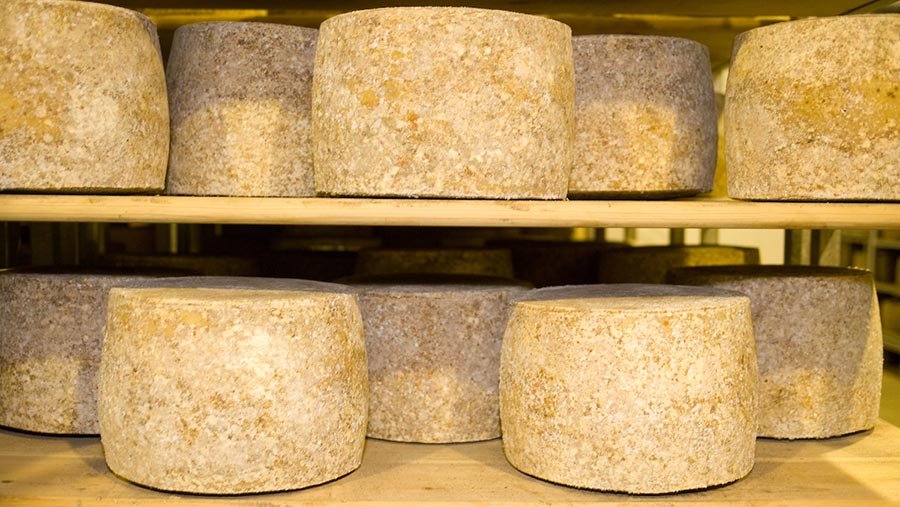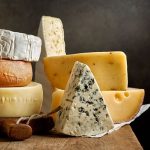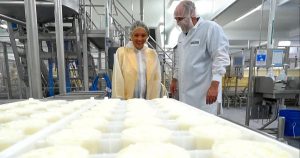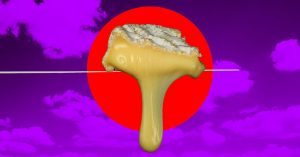
The Cheddar blocks fell to $1.67 per pound on Wednesday, lowest since March 3, but closed Friday at $1.72, down 7 cents on the week and 13 cents above a year ago when the COVID factor began hitting the markets. The blocks tumbled 24.75 cents that week and the barrels were down 9 cents.
The barrels slumped to $1.4375 last Monday but finished Friday at $1.4625, up a penny on the week and 12.25 cents above a year ago. Sales for the week included 4 cars of block and 3 of barrel.
Monday’s market had the blocks up 2.75 cents on 7 trades, as traders contemplated the shortened week, due to the Good Friday holiday, and awaited Thursday’s February Dairy Products report, which will come after trading for the week is completed. The blocks were unchanged Tuesday, holding at $1.7475, with no activity.
The barrels were up 1.75 cents Monday on an unfilled bid and were also unchanged Tuesday, holding at $1.48, 26.75 cents below the blocks.
Dairy Market News reports that some Midwestern cheese producers have been running full schedules while others are picking up. Foodservice cheese demand is not at pre-pandemic levels but has picked up quite a bit in the late winter/early spring season. Cheese availability reports were similar to those of production and vary plant to plant. Some producers are moving cheese out the door while others have available loads here and there. Market tones are mixed.
Foodservice demand for Western cheese continues to rise with the loosening of COVID restrictions while retail demand has held steady. Export demand is strong despite the ongoing issues at the ports and tightness of shipping supplies, although the cargo ship blocking the Suez Canal was finally set free.
DMN says, “As market prices edged lower for block cheese, international buyer interest has ticked back up.” Plenty of milk is available and plants are running at or near capacity but cheese is moving well. Cheese inventories are around or slightly higher than a year ago.
Spot butter got a bounce from last week’s Cold Storage data and closed Friday at $1.7750 per pound, up 11 cents on the week and 28.75 cents above a year ago when the butter had a 26.75 cent meltdown. Sales totaled 7 loads last week.
Monday’s butter added 1.75 cents and it was up another 3 cents Tuesday, hitting $1.8225, highest CME price since June 22, 2020.
Butter contacts tell DMN that foodservice demand has grown but some say it softened slightly from the previous week. General demand tones have “turned a corner from previous months,” says DMN, but “there is a lot of butter available.” Cream tightening continued last week, but “the big question is, which direction cream availability will take following the spring holidays.”
Some contacts expect steadiness then further tightness, while others expect some loosening considering the flush season, but market tones remain “somewhat sturdy.”
Cream is ample in the West, but some contacts expect the supply may start tightening for butter makers as ice cream, sour cream and cream cheese makers are increasing intakes.
Some manufacturers report heavy butter inventories that are still growing.
However, U.S. butter is competitively priced in international markets and export interest remains steady. Retail sales are down slightly compared to early COVID supply stockpiling from a year ago, but retail butter demand is reportedly strong. With restrictions softening and consumer comfort levels growing for dining out, foodservice demand continues to strengthen, says DMN.
Spot Grade A nonfat dry milk also strengthened last week, climbing to a $1.17 per pound Friday close, 1.75 cents higher on the week and 25 cents above a year ago when it fell 6.75 cents. There were 16 CME sales last week.
The powder was up a half-cent both Monday and Tuesday, hitting $1.18 per pound, highest since Jan. 21, 2021.
Dry whey set another record high since trading began on the CME, hitting 62.75 cents per pound last Wednesday, a level not seen in previous NASS-surveyed prices since 2014. It was unchanged the rest of the week, up 1.50 cents on the week and 29.75 cents above a year ago. Only 2 sales were reported all week.
The whey was unchanged Monday but inched up 0.25 cents Tuesday on a trade, to another CME high of 63 cents per pound.
Culling slips
Dairy cow culling was down in February and slightly below February 2020. The latest Livestock Slaughter report shows an estimated 265,200 head were sent to slaughter under federal inspection, down 12,100 head from January and 900 or 0.3% below February 2020. Culling in the first two months of 2021 totaled 542,500 head, down 22,100 or 3.9% from the same period a year ago.
Know your cheese
Hoards Dairyman Managing Editor Corey Geiger gave listeners a lesson on cheese in the March 29 “Dairy Radio Now” broadcast. Based on a recent Hoard’s “Dairy Livestream” program, we talked about blocks and barrels because they are so much a part of milk pricing but Geiger said that the two are not created equal.
Blocks can be either 40 pounds or 640 pounds, while barrels weigh in at 500 pounds. Most plants specialize in one or the other and there’s not much switching between the two. Blocks are usually “ready to eat,” he said, and have a certain flavor and melting consistency. They are also colored by a natural additive and most Americans outside the Northeast eat a yellow Cheddar.
One of the participants in the Livestream was Kurt Epprecht, who operates Ohio-based Great Lakes Cheese Co. Epprecht said that barrels are generally an easier bet for cheesemakers to make because of their valuable white whey.
Most customers who buy whey, a byproduct of the cheese making process, want it to be white, Geiger explained. Whey is typically made from barrel Cheddar which is white and therefore has more value. Many countries stipulate that they will not accept bleached whey, a necessary process if it comes from yellow Cheddar. That’s very important in the infant formula market, Geiger said.
Another topic of the Livestream concerned the use of Mozzarella cheese in milk price discovery. Mozzarella is the most consumed cheese in the U.S., according to Geiger, even ahead of Cheddar, but one of the participants, dairy buyer and trader, Ted Jacoby, CEO of T.C. Jacoby and Co., says including Mozzarella in milk pricing would be “difficult.”
He points out that every plant which produces Mozzarella differs “so an even exchange for Mozzarella is a really difficult thing to establish.” And, “Most Mozzarella is a part-skim product, so you’re automatically skimming fat,” he said, and “the components are different than a whole milk cheese, so that throws off that correlation between Cheddar and Mozzarella. Mozzarella can also be sold frozen, while most Cheddars cannot, so bottom line, Geiger believes block and barrel Cheddar will remain the mainstay in price discovery.
Last of all, we wanted to know: Is barrel cheese really in a barrel? “It used to kind of resemble a chemical or fluid barrel,” answered Epprecht. “It was metal, but since then, it has gone to a plastic bag and a corrugated box with multiple dimensions. It was very much a barrel at one point, but now it’s a cylindrical 500-pound block that is usually vacuum-packed,” he concluded.






















